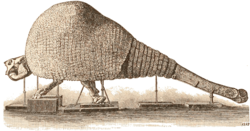Biology:Chlamyphoridae
| Chlamyphoridae Temporal range: Middle Eocene to present
| |
|---|---|

| |
| Southern three-banded armadillo (Tolypeutes matacus) | |

| |
| Illustration of a skeleton of Doedicurus clavicaudatus | |
| Scientific classification | |
| Domain: | Eukaryota |
| Kingdom: | Animalia |
| Phylum: | Chordata |
| Class: | Mammalia |
| Order: | Cingulata |
| Family: | Chlamyphoridae Bonaparte, 1850 |
| Type genus | |
| Chlamyphorus Harlan, 1825
| |
| Subfamilies | |
| |
Chlamyphoridae is a family of cingulate mammals. While glyptodonts have traditionally been considered stem-group cingulates outside the group that contains modern armadillos, there had been speculation that the extant family Dasypodidae could be paraphyletic based on morphological evidence.[1][2][3][4] In 2016, an analysis of Doedicurus mtDNA found it was, in fact, nested within the modern armadillos as the sister group of a clade consisting of Chlamyphorinae and Tolypeutinae.[5][6] For this reason, all extant armadillos but Dasypus were relocated to a new family.
Classification
Below is a taxonomy of the extant species of armadillos in this family.
Family Chlamyphoridae
- Subfamily Chlamyphorinae
- Genus Calyptophractus
- Greater fairy armadillo, Calyptophractus retusus
- Genus Chlamyphorus
- Pink fairy armadillo, Chlamyphorus truncatus
- Genus Calyptophractus
- Subfamily Euphractinae
- Genus Euphractus
- Six-banded armadillo, Euphractus sexcinctus
- Genus Zaedyus
- Pichi, Zaedyus pichiy
- Genus Chaetophractus
- Screaming hairy armadillo, Chaetophractus vellerosus
- Big hairy armadillo, Chaetophractus villosus
- Andean hairy armadillo, Chaetophractus nationi
- Genus Euphractus
- Subfamily Tolypeutinae
- Genus Cabassous
- Greater naked-tailed armadillo, Cabassous tatouay
- Chacoan naked-tailed armadillo, Cabassous chacoensis
- Northern naked-tailed armadillo, Cabassous centralis
- Southern naked-tailed armadillo, Cabassous unicinctus
- Genus Priodontes
- Giant armadillo, Priodontes maximus
- Genus Tolypeutes
- Southern three-banded armadillo, Tolypeutes matacus
- Brazilian three-banded armadillo, Tolypeutes tricinctus
- Genus Cabassous
Phylogeny
Chlamyphoridae, like Dasypodidae, is a basal clade within Cingulata, as shown below.
| Cladogram[5][7][8] | |||||||||||||||||||||||||||||||||||||||||||||||||||||||||||||||||||||||||||||||||||||||||||||
|
References
| Wikimedia Commons has media related to Chlamyphoridae. |
- ↑ Simpson, G. G. (1945). The principles of classification and a classification of mammals. Bull. Amer. Museum Nat. History., 85.
- ↑ Grassé, P. P. (1955). "Ordre des édentés". Traité de zoologie 17 (2): 1182–1246.
- ↑ Engelmann, G. F. (1985). The phylogeny of the Xenarthra. The evolution and ecology of armadillos, sloths, and vermilinguas. Smithsonian Institution Press, Washington, DC, 51-64.
- ↑ Wible, J. R. (2006). 6 The Phylogeny of Living and Extinct Armadillos (Mammalia, Xenarthra, Cingulata): A Craniodental Analysis. Amniote Paleobiology: Perspectives on the Evolution of Mammals, Birds, and Reptiles: University of Chicago Press, Chicago, IL, 153-198.
- ↑ 5.0 5.1 Delsuc, F.; Gibb, G. C.; Kuch, M.; Billet, G.; Hautier, L.; Southon, J.; Rouillard, J.-M.; Fernicola, J. C. et al. (2016-02-22). "The phylogenetic affinities of the extinct glyptodonts". Current Biology 26 (4): R155–R156. doi:10.1016/j.cub.2016.01.039. PMID 26906483. https://hal.archives-ouvertes.fr/hal-01879335.
- ↑ Gillian C. Gibb; Fabien L. Condamine; Melanie Kuch; Jacob Enk; Nadia Moraes-Barros; Mariella Superina; Hendrik N. Poinar; Frédéric Delsuc (2016). "Shotgun Mitogenomics Provides a Reference Phylogenetic Framework and Timescale for Living Xenarthrans". Molecular Biology and Evolution 33 (3): 621–642. doi:10.1093/molbev/msv250. PMID 26556496.
- ↑ Upham, Nathan S.; Esselstyn, Jacob A.; Jetz, Walter (2019). "Inferring the mammal tree: Species-level sets of phylogenies for questions in ecology, evolution and conservation". PLOS Biol 17 (12): e3000494. doi:10.1371/journal.pbio.3000494. PMID 31800571.
- ↑ Gibb, Gillian C.; Condamine, Fabien L.; Kuch, Melanie; Enk, Jacob; Moraes-Barros, Nadia; Superina, Mariella; Poinar, Hendrik N.; Delsuc, Frédéric (2015). "Shotgun Mitogenomics Provides a Reference PhyloGenetic Framework and Timescale for Living Xenarthrans". Molecular Biology and Evolution 33 (3): 621–642. doi:10.1093/molbev/msv250. PMID 26556496.
Wikidata ☰ Q22924208 entry
 |


